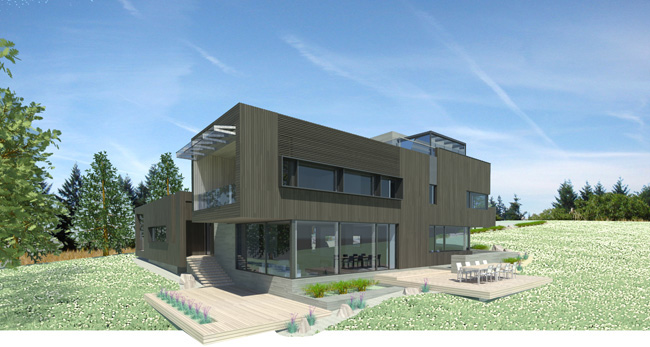The green building showcase, designed by Holst Architecture and built by Hammer & Hand, reaches key milestone.
Holst Architecture and Hammer & Hand are happy to announce that the Karuna House in Newberg, Oregon has earned the first Minergie pre-certification in the United States, with official designation as “US-001-P-ECO.” The pre-certification by the Swiss green building quality label means that the project is on track to be the first U.S. home to achieve the stringent energy performance and sustainability requirements of Minergie P-ECO.

rendering courtesy of Holst Architecture
“It’s an honor to be working on the first pre-certified Minergie project in the country,” said Jeff Stuhr, principal at Holst. “We’re so pleased to reach this milestone. The requirements of Minergie-P-ECO demand a thorough, holistic approach to green building.”
Launched in 1998, the Minergie suite of green building standards is widely accepted throughout Europe as an effective tool for cutting energy usage and subsequent costs in residential and commercial buildings. Like Passive House, Minergie doesn’t prescribe any specific building materials or technologies, but instead focuses on the performance of the building envelope and ventilation system to reach high levels of energy efficiency and comfort.
Compared to a conventional structure, a Minergie-P-ECO-certified building can cut energy costs by up to 60 percent. The “P” of Minergie-P-ECO adds requirements for very high-building energy performance, similar to Passive House. The “ECO” denotes that a project has met the stringent ecology and healthy building requirements of ECO-Bau, a sustainability organization partnering with Minergie on the “ECO” label.
“We’re proud to support the Minergie-P-ECO certification effort of the Karuna project,” said Stephan Tanner, Principal of Intep and Minergie consultant for the project. “I found the challenge of bringing a building performance standard from one building culture to another very engaging. What seems easily understood at the place of origin can become ‘non applicable’, an ‘interesting new approach’ or even ‘something we should do always’ and as such has positive learning components for both sides.”
Designed by Holst Architecture and constructed by Hammer And Hand, the Karuna House is an ambitious green building project that aims to meet a combination of the world’s most demanding green building certifications. In addition to Minergie -P-ECO certification, the Karuna House aims to achieve Passive House PHIUS+, and LEED for Homes Platinum.
The Karuna House’s client, a leading proponent of smart climate policy and sound land use, is pursuing the project as a case study to shed light on the ways that the leading green building certifications and standards complement and/or conflict with one another.
“It’s a great challenge,” says Sam Hagerman, co-owner of Hammer And Hand. “When you line up the various aims of the standards you’re left with a pretty narrow path to navigate through in design and construction. It’s been an exciting journey, and one with significant environmental rewards and lessons.”
– Allison Milionis (Holst Architecture) and Zack Semke (Hammer & Hand)
Back to Field Notes